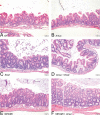Akkermansia muciniphila strain ATCC BAA-835 does not promote short-term intestinal inflammation in gnotobiotic interleukin-10-deficient mice
- PMID: 30252588
- PMCID: PMC6546315
- DOI: 10.1080/19490976.2018.1511663
Akkermansia muciniphila strain ATCC BAA-835 does not promote short-term intestinal inflammation in gnotobiotic interleukin-10-deficient mice
Abstract
Akkermansia muciniphila is a common member of the intestinal microbiota of healthy human individuals. Its abundance is negatively associated with inflammatory bowel disease and metabolic disorders and the oral administration of A. muciniphila improves the symptoms of metabolic disease in mice. Therefore, A. muciniphila is a promising candidate for the treatment of type-2 diabetes and obesity. However, some studies using animal models of intestinal inflammation reported that A. muciniphila may exacerbate gut inflammation. Because of these contradictory reports the present study aimed to clarify the role of A. muciniphila in the development of intestinal inflammation and the conditions promoting it. For this purpose, the short-term colitogenic potential of A. muciniphila strain ATCC BAA-835 was investigated in colitis-prone, gnotobiotic IL-10-deficient (Il10-/-) mice. Il10-/- mice mono-associated with A. muciniphila showed no signs of intestinal inflammation based on body-weight change, histopathological scoring and inflammatory markers. Additional association of the mice with the colitogenic Escherichia coli strain NC101 led to cecal but not colonic inflammation. However, the severity of the inflammation did not exceed that observed in mice mono-associated with E. coli NC101. Il10-/- mice colonized with a simplified human intestinal microbiota showed increased histopathology, but no increase in inflammatory markers. Furthermore, co-colonization with A. muciniphila did not modify histopathology. The turnover of intestinal mucus was similar in all groups despite the mucus-degrading property of A. muciniphila. Overall, the data do not support a short-term pro-inflammatory effect of A. muciniphila strain ATCC BAA-835 in the Il10-/- mouse model for inflammatory bowel disease.
Keywords: NC101; IL-10-deficient; gnotobiotic mice; intestinal inflammation; simplified human intestinal microbiota.
Figures






Similar articles
-
Strain-Specific Anti-inflammatory Properties of Two Akkermansia muciniphila Strains on Chronic Colitis in Mice.Front Cell Infect Microbiol. 2019 Jul 5;9:239. doi: 10.3389/fcimb.2019.00239. eCollection 2019. Front Cell Infect Microbiol. 2019. PMID: 31334133 Free PMC article.
-
Commensal Akkermansia muciniphila exacerbates gut inflammation in Salmonella Typhimurium-infected gnotobiotic mice.PLoS One. 2013 Sep 10;8(9):e74963. doi: 10.1371/journal.pone.0074963. eCollection 2013. PLoS One. 2013. PMID: 24040367 Free PMC article.
-
NLRP6 Protects Il10-/- Mice from Colitis by Limiting Colonization of Akkermansia muciniphila.Cell Rep. 2017 Apr 25;19(4):733-745. doi: 10.1016/j.celrep.2017.03.080. Cell Rep. 2017. PMID: 28445725 Free PMC article.
-
Akkermansia muciniphila and its role in regulating host functions.Microb Pathog. 2017 May;106:171-181. doi: 10.1016/j.micpath.2016.02.005. Epub 2016 Feb 11. Microb Pathog. 2017. PMID: 26875998 Review.
-
Akkermansia muciniphila: key player in metabolic and gastrointestinal disorders.Eur Rev Med Pharmacol Sci. 2019 Sep;23(18):8075-8083. doi: 10.26355/eurrev_201909_19024. Eur Rev Med Pharmacol Sci. 2019. PMID: 31599433 Review.
Cited by
-
Synthetic Microbiomes on the Rise-Application in Deciphering the Role of Microbes in Host Health and Disease.Nutrients. 2021 Nov 21;13(11):4173. doi: 10.3390/nu13114173. Nutrients. 2021. PMID: 34836426 Free PMC article. Review.
-
Total flavone of Abelmoschus Manihot improves colitis by promoting the growth of Akkermansia in mice.Sci Rep. 2021 Oct 21;11(1):20787. doi: 10.1038/s41598-021-00070-7. Sci Rep. 2021. PMID: 34675239 Free PMC article.
-
Function of Akkermansia muciniphila in type 2 diabetes and related diseases.Front Microbiol. 2023 Jun 15;14:1172400. doi: 10.3389/fmicb.2023.1172400. eCollection 2023. Front Microbiol. 2023. PMID: 37396381 Free PMC article. Review.
-
Study on the mechanism of lactic acid bacteria and their fermentation broth in alleviating hyperuricemia based on metabolomics and gut microbiota.Front Nutr. 2024 Dec 4;11:1495346. doi: 10.3389/fnut.2024.1495346. eCollection 2024. Front Nutr. 2024. PMID: 39698246 Free PMC article.
-
Synthetic microbial communities (SynComs) of the human gut: design, assembly, and applications.FEMS Microbiol Rev. 2023 Mar 10;47(2):fuad012. doi: 10.1093/femsre/fuad012. FEMS Microbiol Rev. 2023. PMID: 36931888 Free PMC article.
References
-
- Collado MC, Derrien M, Isolauri E, de Vos WM, Salminen S. Intestinal integrity and Akkermansia muciniphila, a mucin-degrading member of the intestinal microbiota present in infants, adults, and the elderly. Appl Environ Microbiol. 2007;73(23):7767–7770. doi:10.1128/AEM.01477-07. - DOI - PMC - PubMed
Publication types
MeSH terms
Substances
LinkOut - more resources
Full Text Sources
Other Literature Sources
Molecular Biology Databases
